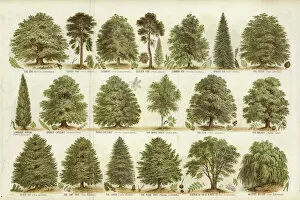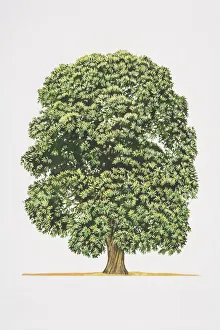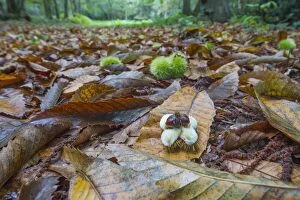Spanish Chestnut Collection
The Spanish Chestnut, also known as the Sweet Chestnut tree (Castanea sativa), is a majestic species that can be found in British forests
All Professionally Made to Order for Quick Shipping
The Spanish Chestnut, also known as the Sweet Chestnut tree (Castanea sativa), is a majestic species that can be found in British forests. This beautiful tree, depicted in John Ruskin's artwork "Our British Forest Trees, " showcases its vibrant colors through a color litho print. With its flowering season occurring both in spring and summer, the Spanish Chestnut displays stunning blossoms that add charm to any landscape. Its flowers are a sight to behold, attracting bees and other pollinators with their sweet nectar. As autumn approaches, the leaves of the Sweet Chestnut begin to change into vibrant hues of reds and oranges. In Kent's coppice woodland habitat or Norfolk's leaf litter-covered floor, one can witness this transformation up close. But it is not just the foliage that captivates us; it is also the fruit of this remarkable tree. The nuts produced by the Sweet Chestnut are showcased in various photographs from France to Suffolk. Whether they are closed or open fruits nestled among fallen leaves or growing on woodland floors, these chestnuts symbolize abundance and nourishment. The significance of this species extends beyond aesthetics. The Spanish Chestnut has been utilized for centuries for its timber properties due to its comprehensive work on all species of wood by Ruskin himself and has been used in construction projects such as railway bridges like Chatou's iconic structure painted by an artist back in 1881. Whether you appreciate its artistic representation or encounter it firsthand while exploring British woodlands, there is no denying the allure of the Spanish Chestnut tree (Fagus Castanea). From its captivating flowers during spring and summer to its breathtaking autumn foliage and bountiful harvests of nuts – this magnificent tree truly deserves our admiration.













